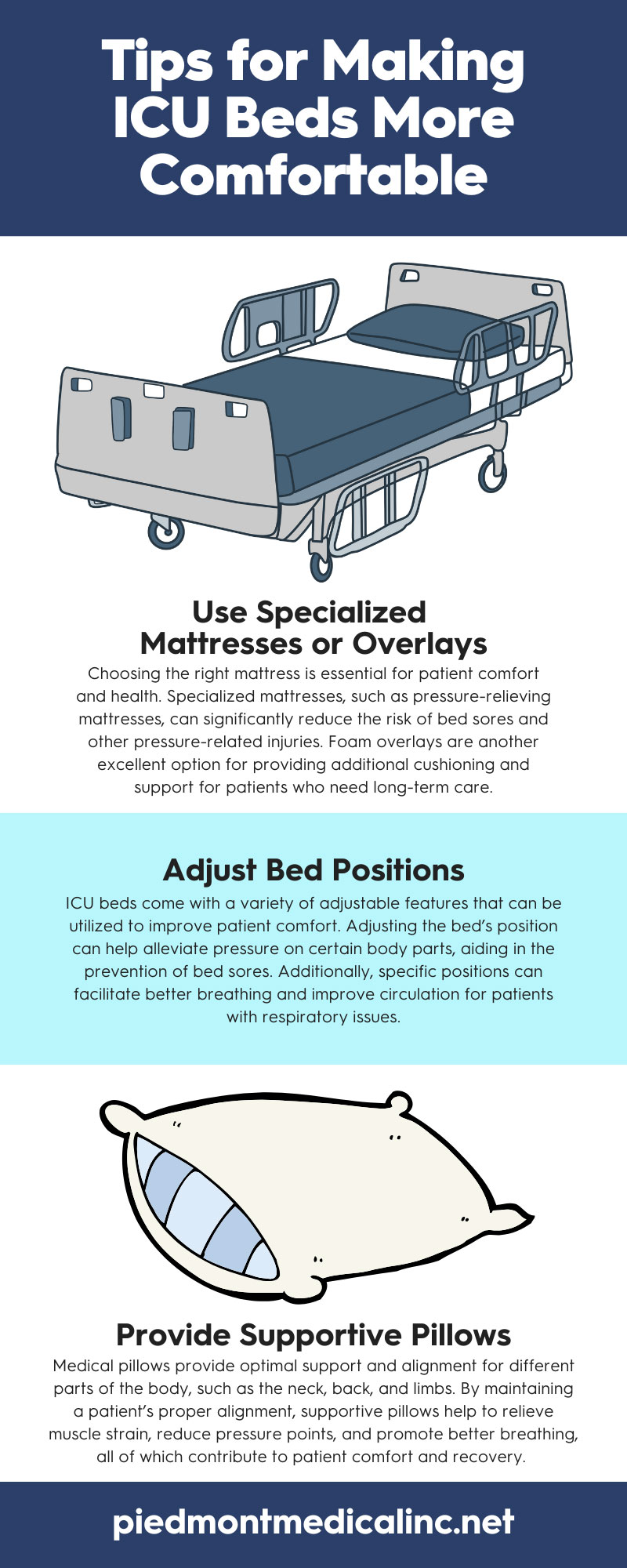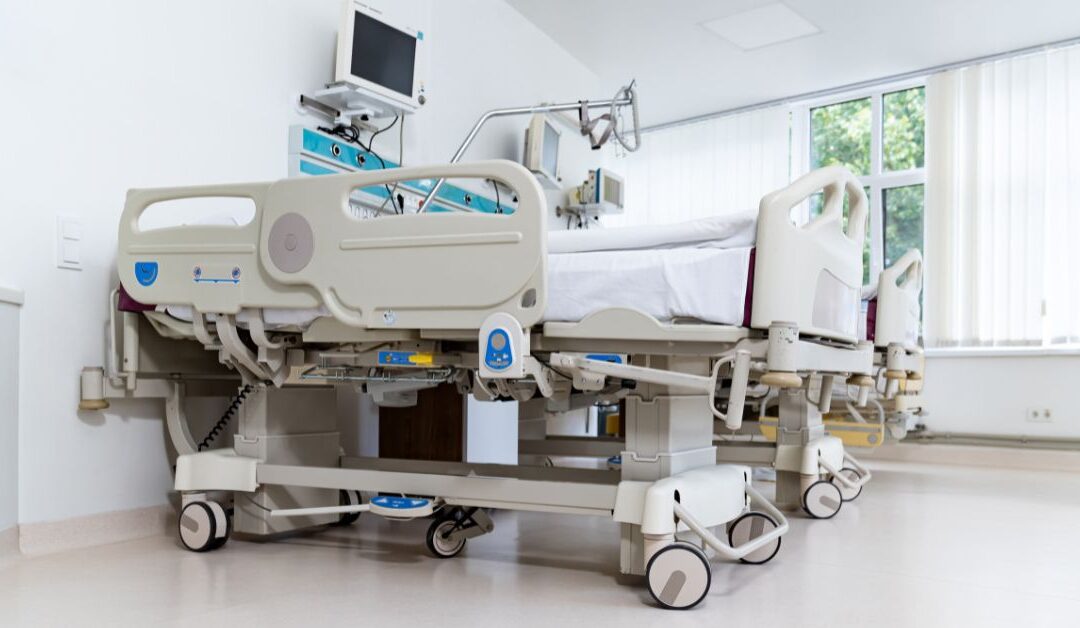Creating a comfortable environment in intensive care units (ICUs) is critical for patient recovery and overall well-being. Patients in ICUs can be in various states of consciousness, ranging from fully awake and aware to semi-conscious or in an induced coma. Each level of awareness requires different considerations for comfort and well-being. Healthcare professionals can use these six tips for making ICU beds more comfortable to tailor the care environment to meet each patient’s specific needs.
Use Specialized Mattresses or Overlays
Choosing the right mattress is essential for patient comfort and health. Specialized mattresses, such as pressure-relieving mattresses, can significantly reduce the risk of bed sores and other pressure-related injuries. Foam overlays are another excellent option for providing additional cushioning and support for patients who need long-term care.
These specialized tools are designed to distribute weight evenly, which optimizes circulation, aiding in the healing process and preventing complications associated with poor blood flow. Additionally, specialized mattresses help patients get better quality rest, which contributes to faster recovery.
Adjust Bed Positions
ICU beds come with a variety of adjustable features that can be utilized to improve patient comfort. Adjusting the bed’s position can help alleviate pressure on certain body parts, aiding in the prevention of bed sores. Additionally, specific positions can facilitate better breathing and improve circulation for patients with respiratory issues.
Medical care providers should reposition their patients at scheduled intervals to ensure even weight distribution. A high-quality ICU patient bed simplifies adjustments, allowing healthcare professionals to easily modify the beds’ positions to meet the changing needs of their patients. These beds offer more precise positioning options, which can be critical for patients with specific medical conditions or during certain treatment procedures.
Provide Supportive Pillows
Another way to make ICU beds more comfortable is to use medical cushions and support pillows. Medical pillows provide optimal support and alignment for different parts of the body, such as the neck, back, and limbs. By maintaining a patient’s proper alignment, supportive pillows help to relieve muscle strain, reduce pressure points, and promote better breathing, all of which contribute to patient comfort and recovery. Additionally, these pillows come in various shapes and sizes, allowing healthcare professionals to customize support according to each patient’s unique needs and medical requirements.
In addition to supportive pillows, other tools like positioning wedges and foot lift pillows can greatly benefit ICU patients. Positioning wedges help maintain specific angles and positions, which can assist in improving circulation and reducing the risk of pressure sores. Foot lift pillows prevent foot drop by keeping the feet and ankles in a stable and supported position. By providing a range of supportive pillows, healthcare professionals can help their patients find the optimal configurations for recovery.
Offer Noise-Canceling Headphones
The ICU environment can be noisy, with alarms, monitors, and conversations creating a challenging auditory landscape. A study originally published in the journal Noise and Health found that noise pollution in ICUs negatively affects patients’ health. Constant auditory stimuli can disrupt a patient’s rest and sleep, complicating recovery and potentially increasing stress levels.
Noise-canceling headphones provide a valuable solution to mitigate the auditory challenges faced by patients in the ICU. These headphones utilize active noise control technology, which involves generating a sound wave that is the exact opposite (or inverse) of the ambient noise, effectively canceling it out. By providing a quieter environment, noise-canceling headphones can enhance a patient’s focus and improve their rest periods, contributing to better recovery.
Provide Easy Access to Call Buttons and Personal Items
Ensuring that call buttons and essential personal items are within easy reach of the patient is vital for reducing stress and enhancing their sense of control. Patients should feel confident that they can easily communicate their needs to healthcare professionals.
Easy access to call buttons and personal items empowers patients and improves their overall experience. Healthcare professionals should regularly check and adjust the placement of these items to accommodate their patients’ needs and ensure comfort while in an ICU bed.
Take Care of the Patient’s Skin
Prolonged stays in the ICU can lead to various skin problems due to immobility and constant exposure to medical equipment. Skin complications can increase a patient’s pain and discomfort, worsening how they feel in bed.
ICU patients can experience the following skin problems:
- Pressure ulcers: These occur when constant pressure against the skin reduces blood flow to the area, commonly on bony parts of the body, leading to sores and skin breakdown.
- Contact dermatitis: This skin irritation is caused by exposure to medical adhesives or antiseptic agents, resulting in redness, itching, and inflammation.
- Dry skin: Dehydration and low humidity in the ICU can lead to cracked, itchy skin as the natural moisture barrier becomes disturbed.
- Infections: Skin infections can develop when breaks in the skin are exposed to bacteria, which is often caused by invasive procedures or prolonged hospital stays.
- Edema: Characterized by swollen skin due to fluid accumulation, edema is often a result of limited mobility and the body’s compromised ability to circulate fluids.
- Moisture-associated skin damage (MASD): Prolonged exposure to moisture from sweat or incontinence can cause irritation and compromise the integrity of the skin barrier. This exposure leads to maceration, where the skin becomes overly hydrated, soft, and more susceptible to breakdown and infection.
Patient Skincare Tips
To address these skin-related challenges, healthcare professionals can implement preventive skincare protocols. Regular repositioning of patients alleviates pressure and enhances circulation, reducing the risk of bed sores.
Applying barrier creams and moisturizers helps maintain skin integrity by providing a protective layer against moisture and friction. Adequate hygiene routines, including gentle cleansing and drying of the skin, help prevent infections and promote healing. Comprehensive skincare can decrease recovery times and lower the risk of secondary complications.
Preventing Skin Shearing
Skin shearing occurs when layers of skin slide in opposing directions, typically due to friction and gravity acting on the body. This movement causes internal tissue damage beneath the skin’s surface, increasing the risk of pressure ulcers and complicating recovery for ICU patients.
To minimize the risk of skin shearing, healthcare professionals should employ careful handling techniques when moving or repositioning patients. It’s crucial to lift, rather than drag, the patient across the bed to avoid excessive pulling on the skin. Furthermore, ensuring that all bedding and clothing are smooth and free of wrinkles can help reduce pressure and shear stress.
A comfortable environment helps patients avoid complications and recover faster. Quality ICU beds, frequent repositioning, and supportive pillows and wedges keep patients in the best positions for recovery. Additionally, managing noise levels and taking care of their skin helps patients feel more at ease. Finally, easy access to communication devices and personal belongings bolsters patient safety and confidence while in the ICU.



Recent Comments